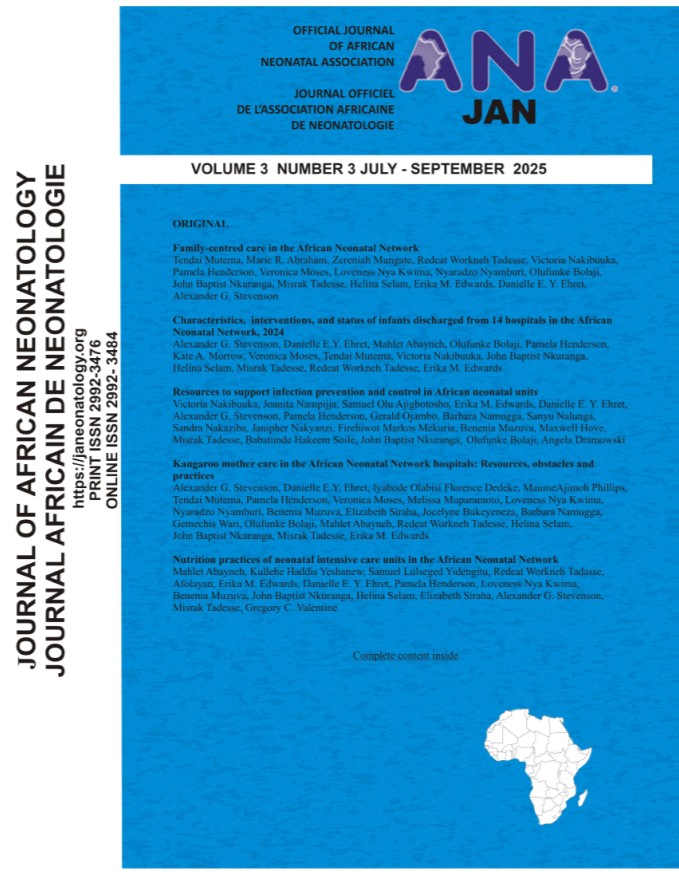Current staffing landscape in neonatal units in Africa: Insights from the African Neonatal Network
Keywords:
Infant, Newborn; Infant, Premature; Neonatal Intensive Care Units; Health Personnel / standards; Neonatal Nursing / organization & administration; Nurse-Patient Ratio; Workforce; Africa South of the Sahara; Global HealthAbstract
Background: Despite recommendations, healthcare workforce standards for neonatal units in low- and middle-income countries remain largely undefined.
Methods: Fourteen hospitals in the African Neonatal Network responded to an annual facility survey and a health facility survey co-developed by faculty in the African Neonatal Network and Vermont Oxford Network. All analyses use descriptive statistics.
Result: Most neonatologists/paediatricians (71%) were on call at home some of the time, with 21.4% available on call in the hospital. Most hospitals (71%) considered neonatal nursing a specialty. Nurses typically had specific patient assignments (93%), with nurse-to-patient ratios based on acuity (64%). The median number of full-time equivalent nurses was 16, with an average of 6 nurses on day shifts and 5 on night shifts. Respiratory support varied, with mechanical ventilation used most at nurse-to-patient ratios of 1:1 to 1:4 and 1:1, and 1:3 to 4 ratios (21%), and CPAP most commonly at a 1:3-4 ratio (43%). For stable, growing premature infants weighing over 1500 grams, 5 (36%) hospitals reported ratios of 1:3-4 while eight (57%) hospitals reported ratios of either 1:5-7 or 1:8-10. The median number of patients per nurse was 4 on weekdays, and 5 on nights and weekends.
Conclusion: This study underscores the urgent need for standardized staffing guidelines tailored to the unique contexts of sub -Saharan African neonatal units. Addressing staffing inconsistencies and retention issues is essential to enhance the quality of neonatal care and improve health outcomes. Collaborative efforts are imperative to establish standardized workforce criteria, ultimately promoting better health for newborns.
References
World Health Organization. Global Health Estimates: Neonatal Mortality [Internet]. Geneva: World Health Organization, 2023. Available from https://www.who.int/data/gho/data/themes/mortality-andglobal-health-estimates.
World Bank Health and Mortality Statistics. Washington, DC: World Bank Group, 2023. Available from https://data.worldbank.org/topic/health.
World Health Organization, UNICEF. Every Newborn: An Action Plan to End Preventable Deaths. Geneva: World Health Organization; 2014.
UNICEF. Progress on the Sustainable Development Goals: The Situation of Children in Sub-Saharan Africa. New York: UNICEF, 2022. Available from https://www.unicef.org/reports/progress-sustainable-development-goals.
World Health Organization. Everybody’s Business: Strengthening Health Systems to Improve Health Outcomes. Geneva, Switzerland: 2007.
Association of Women’s Health, Obstetric, and Neonatal Nurses. Standards for professional registered nurse staffing for perinatal units. J Obstet Gynecol Neonatal Nurs. 2022;51(4):e5-e98.
Mader S, Thiele N, Walz, JM (ed). European Standards of Care for Newborn Health project report. Munich: Global Foundation for the Care of Newborns, 2018.
National Quality Board. Safe, sustainable and productive staffing: An improvement resource for neonatal care (Edition 1). London: National Health Service, 2018.
Horwood C, Haskins L, Phakathi S, McKerrow N. A health systems strengthening intervention to improve quality of care for sick and small newborn infants: results from an evaluation in district hospitals in KwaZulu-Natal, South Africa. BMC Pediatr. 2019;19(1):29.
Kalyan, G., Joshi, P., Levis Murry, L., Campbell-Yeo, M., &Tiwarie, S. K. Transforming neonatal nursing in India: Challenges, opportunities, and the way forward. Lancet Reg Health Southeast Asia. 2024;32:100522.
World Health Organization. Human Resource Strategies to Improve Newborn Care in Health Facilities in Low- and Middle-Income Countries. Geneva: World Health Organization, 2020.
WHO-UNICEF Expert and Country Consultation on Small and/or Sick Newborn Care Group. A comprehensive model for scaling up care for small and/or sick newborns at district level–based on country experiences presented at a WHO-UNICEF expert consultation. J Glob Health. 2023; 11:03023.
March of Dimes, WHO, and Save the Children. Born Too Soon: The Global Action Report on Preterm Birth. Geneva: World Health Organization, 2012.
Helping Babies Breathe. Training Healthcare Providers in LMICs on Essential Newborn Care. Helping Babies Breathe initiative. 2020.
National Association of Neonatal Nurses. RN staffing in the NICU (Position Statement No. 3074), 2021. Available at:https://nann.org/uploads/RN_Staffing_in_the_NICU_Position_Statement.pdf
Lawn JE, Blencowe H, Oza S, You D, Lee AC, Waiswa P, Lalli M, Bhutta Z, Barros AJ, Christian P, Mathers C, Cousens SN; Lancet Every Newborn Study Group. Every Newborn: progress, priorities, and potential beyond survival. Lancet. 2014;384(9938):189-205.
World Health Organization. State of the World’s Nursing Report 2020: Investing in Education, Jobs, and Leadership. Geneva: World Health Organization, 2020.
Gathara D, Serem G, Murphy GAV, Obengo A, Tallam E, Jackson D, Brownie S, English M. Missed nursing care in newborn units: a crosssectional direct observational study. BMJ Qual Saf. 2020;29 (1):19-30.
Feldman K, Rohan AJ. Data driven nurse staffing in the neonatal intensive care unit. MCN Am J Matern Child Nurs. 2022;47(5):249-264.
Oluoch D, Murphy G, Gathara D, Abuya N, Nzinga J, English M, Jones C. Neonatal nursing policy and practice in Kenya: Key takeholders and their views on task shifting as an intervention to improve care quality. Wellcome Open Research 2018,3:35.
Gebrekidan AY, Enaro EY, Azeze G, Adella GA, Kassie GA, Haile KE, Asgedom YS. Turnover intention among healthcare workers in Ethiopia: a systematic review and meta-analysis. BMJ Open 2023;13(5):e067266.
Ryan I, Shah KV, Barrero CE, Uamunovandu T, Ilbawi A, Swanson J. Task shifting and task sharing to strengthen the surgical workforce in sub-Saharan Africa: A systematic review of the existing literature. World J Surg. 2023;47 (12):3070-3080.
Downloads
Published
Issue
Section
License
Copyright (c) 2025 JOURNAL OF AFRICAN NEONATOLOGY

This work is licensed under a Creative Commons Attribution-NonCommercial-ShareAlike 4.0 International License.
This is an open-access journal, and articles are distributed under the terms of the Creative Commons Attribution-NonCommercial-ShareAlike 4.0 License, which allows others to remix, tweak, and build upon the work non-commercially, as long as appropriate credit is given and the new creations are licensed under the identical terms.

